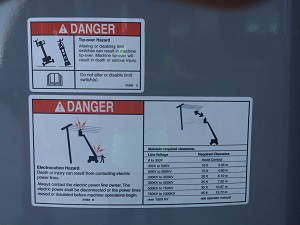Overhead power lines at the job site are hazardous because they carry extremely high voltage. Fatal electrocution is the main risk but burns and falls from elevations are also hazards. Using tools and equipment that can contact the power lines increases the risk.

Overhead power lines are not insulated and can carry tens of thousands of volts, making them extremely dangerous to anyone working nearby.
Equipment Dangers Near Power Lines
Examples of equipment that can contact power lines:
- Aluminum Paint Rollers
- Backhoes
- Concrete Pumpers
- Cranes
- Forklifts
- Long-Handled Cement Finishing Floats
- Metal Building Materials
- Metal Ladders
- Raised Dump Truck Beds
- Scaffolds
OSHA Standard 1926.416(a)(1) No employer shall permit an employee to work in such proximity to any part of an electric power circuit that the employee could contact the electric power circuit in the course of work, unless the employee is protected against electric shock by deenergizing the circuit and grounding it or by guarding it effectively by insulation or other means.
Work Distance Recommendations
The general rule is to stay at least 10 feet away from overhead power lines which pertains to personnel, equipment, scaffolding and ladders. However, for higher voltages, the power line clearance requirements increase.

It’s important to review the OSHA standards for the work activities and equipment being used to ensure that minimum distances are maintained for the safety of all workers including equipment operators and ground crew.
OSHA Standard 1926.1407-1411 provides the requirements for power line safety when working with cranes and derricks in construction.
Brick masons, carpenters, painters, construction laborers, plasterers, and others who use scaffolding may risk contact with energized overhead power lines.
OSHA Standard 1926.451(f)(6) provides the requirements for scaffolding safety near power lines.
Overhead power lines are often hit by equipment and these dangerous incidents result in many fatalities every year. Putting visible signs on the job site can alert drivers that they are near the lines. Overhead flags can also give drivers a visual idea of the safety clearance needed to avoid hitting the lines.
Before working under or near overhead power lines, ensure that you maintain a safe distance to the lines and, for very high-voltage lines, ground any equipment such as cranes that can become energized.
Power Line Safety Recommendations
If working on power lines, ensure that the lines have been deenergized and grounded by the owner or operator of the lines. Other protective measures like guarding or insulating the lines help prevent accidental contact.

When working near power lines, all workers must be trained on safety procedures and requirements. Workers unqualified to work with electricity, as well as mechanical equipment, should remain at least 10 feet away from overhead power lines. Important: If the voltage is more than 50,000 volts, the clearance requirement increases.
Using Cranes Near Power Lines
When mechanical equipment is operated near overhead lines, employees standing on the ground should avoid contact with the equipment unless it is located outside the danger zone. When factoring the safe clearance distance, be sure to consider the equipment’s maximum reach. Assume all power lines are energized unless the owner of the line or electric utility company indicates otherwise.
OSHA Standard 1926.1408(g)(1)(ii) Power lines are presumed to be energized unless the utility owner/operator confirms that the power line has been and continues to be deenergized and visibly grounded at the worksite.
Training and Hazard Assessment
All workers should complete training in hazard recognition, the avoidance of unsafe conditions, and electrical safe work practices.
Always survey the site for overhead power lines. Look up! Conduct a hazard assessment to identify and address potential safety hazards before work begins. Conduct a jobsite survey to identify potential hazards and develop and implement appropriate control measures for these hazards.
Follow existing OSHA regulations and safe work practices concerning the operation of cranes or equipment in close proximity to overhead power lines, and if necessary, take steps to de-energize or insulate power lines before work begins.

Visibility Requirements
Ensure that when working near a high voltage overhead power line where visibility could be obstructed or clearances difficult to determine, an observer is used to help the operator maintain the required clearance.
Use non-conductive wood or fiberglass ladders when working near power lines.
OSHA Standard 1926.955(c) Portable metal ladders and other portable conductive ladders may not be used near exposed energized lines or equipment.
Job Hazard Awareness
Increase job site hazard awareness by posting signs reminding crews and equipment operators of the overhead power line dangers. Signs can include a warning that failing to maintain safe minimum clearances can result in electrocution.
Never use cranes or equipment alone where it is difficult to maintain the minimum required distance from overhead power lines. A trained observer can assist to help the operator maintain a safe clearance.
When in doubt, call the electric company to find out what voltage is on the lines.


.jpg)
